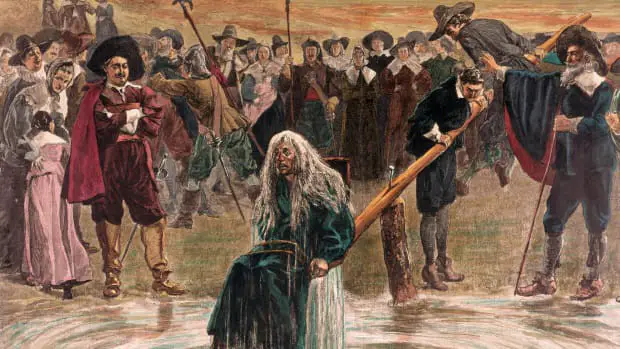 he practices of black magic had long been considered a heinous crime, similar to rape or murder. Hammurabi’s code from the 18th century B.C. contained details of witchcraft, and many medieval systems contained specific parameters for identifying, judging, and executing suspicious witches and wizards. From barbaric torture and occult desserts to the detection of witches, here is a list of evidence that would have indicated the past existence of a person who practiced black magic.
he practices of black magic had long been considered a heinous crime, similar to rape or murder. Hammurabi’s code from the 18th century B.C. contained details of witchcraft, and many medieval systems contained specific parameters for identifying, judging, and executing suspicious witches and wizards. From barbaric torture and occult desserts to the detection of witches, here is a list of evidence that would have indicated the past existence of a person who practiced black magic.
1. Swimming test
People accused of witchcraft were dragged to the first place with water, undressed, and thrown into the water for judges to see if the person was floating or sinking. Since the witches would disregard the Baptist oath, it was considered that the water would not allow the body to sink. According to this logic, an innocent person would have sunk like a stone, and a witch would have floated to the surface. The victim usually had a rope tied to the middle through which he could be pulled out of the water if he sank, but they often died due to drowning.
2. The prayer test
In medieval times, it was believed that witches could not utter words in scripture, so those accused were forced to recite a prayer from the Bible, usually “Our Father”, without making any mistakes. If the person was wrong for any reason she was considered a witch who speaks in the name of the devil. In 1712, the method was applied to Jane Wenham, a woman accused of witchcraft who seems to have struggled to utter the words “forgive us our sins and lead us not into temptation.” During the Salem Witch Trial, the sorcerer George Burroughs recited the prayer without interruption before it was performed. Even in this case, the gesture was considered a trick of the devil, and the man was hanged.
3. Touch test
The touch test was based on the fact that witches have a special reaction to physical contact. If they did not make any gesture, they were considered innocent, but if they moved, it was considered a gesture that proved the existence of occult forces.
4. The witch’s cake
The witch’s cake was considered a supernatural dessert to identify suspicious witches. In the event of mysterious illness or possession, witch hunters took a sample of the victim’s urine, mixed it with rye flour and ash, and baked the mixture into a cake. This mixture was then fed to a dog in the hope that it would be enchanted and say the wizard’s name.
5. Signs of witches
Witch hunters undressed and examined suspects in public. They believed that there were signs on the witch’s body of the covenant the person had made with the devil. The “Devil’s Sign” would have been insensitive to pain. Even the smallest corporal imperfections were considered occult signs, from moles, extra nipples, and scars.
6. Incantations
The test involved forcing the accused person to verbally order the devil to allow the possessed person to get out of the trance. The practice was often used in the 16th century during the trial of Alice Samuel and her entire family. The judges forced the husbands to utter the following incantation to free the girls from his spell: “I am a witch, so I ask the devil to allow Mrs. Trockmorton to wake up from the spell.”
These sorts of incantations were believed by some to not really have an effect or the effect mentioned within the incantation itself, but to scare people of thinking that they might be cursed with a deadly disease.
If a witch or a wizard were identified, they would end up being executed by being burned alive. Legends say that this type of execution was chosen in order to make sure that the soul of the wizard/witch was burned so that it would not come back to haunt others.
Avid Writer with invaluable knowledge of Humanity!
Upcoming historian with over 30 million views online.
“You make your own life.”





